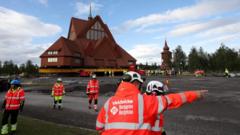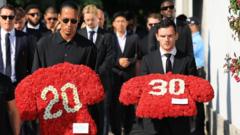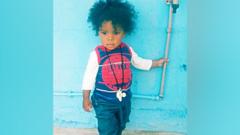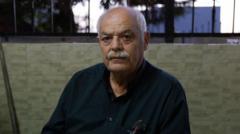The monumental relocation symbolizes the city's efforts to adapt to environmental challenges.
**Historic Swedish Church Embarks on Two-Day Relocation Journey**
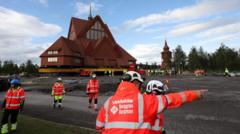
**Historic Swedish Church Embarks on Two-Day Relocation Journey**
A 113-year-old landmark church in Kiruna is being moved to safeguard it from ground subsidence due to mining activities.
The historic Kiruna Church, which has stood since 1912, began its remarkable journey across the northern Swedish city early Tuesday morning. The entire structure, weighing 672 tonnes, is being relocated a distance of 5 km (3 miles) along a specially prepared road to avoid fissures caused by over a century of iron ore mining in the region.
This intricate operation involves lifting the church on giant rolling platforms and moving it at a maximum speed of 500 meters per hour. The operation is anticipated to take two days, marking a significant milestone in the ongoing relocation efforts within Kiruna, located about 145 kilometers north of the Arctic Circle. With mining activities threatening the stability of the old city center, the move of such a prominent structure is not only a feat of engineering but also serves as a powerful symbol of resilience amidst environmental change.
Project manager Stefan Holmblad Johansson, who has meticulously planned this venture, expressed his confidence in the operation: “It’s a historic event, very complex, and we don’t have a margin of error. But everything is under control.”
Alongside the church, which has been a spiritual hub for the community for generations, other significant buildings in Kiruna have also been relocated or rebuilt in safer areas. Despite challenges, the city's development company, supported by LKAB, the main employer in the region, is navigating the transition for its residents. The relocation costs are projected to exceed 10 billion Swedish krona (approximately $1 billion).
The church, noted for its beauty and excellent craftsmanship, measures 35 meters high and 40 meters wide, and has a rich cultural heritage—especially with treasures like its altar painting by Prince Eugen and an intricate organ with over 1,000 pipes. These elements have been secured for protection during the move, ensuring they remain intact.
Residents of Kiruna are emotionally invested in the move, with many anticipating it will evoke cherished memories of communal gatherings and spiritual unity. Sofia Lagerlöf Määttä, a cultural strategist, encapsulated this sentiment, remarking that the relocation carries with it memories of joy and sorrow, now projected into the future.
For vicar Lena Tjärnberg, the relocation also symbolizes a bittersweet farewell. “The church is leaving a place where it truly belongs,” she noted. This relocation event has captured the attention of the public, with thousands expected to line the path of the church's journey, including Sweden’s King Carl Gustaf, all coming together to witness this seldom-seen live event broadcasted on Swedish television.
As the massive structure inches forward, it stands as a testament to Kiruna's adaptability—a community committed to shaping its future while honoring its past.
This intricate operation involves lifting the church on giant rolling platforms and moving it at a maximum speed of 500 meters per hour. The operation is anticipated to take two days, marking a significant milestone in the ongoing relocation efforts within Kiruna, located about 145 kilometers north of the Arctic Circle. With mining activities threatening the stability of the old city center, the move of such a prominent structure is not only a feat of engineering but also serves as a powerful symbol of resilience amidst environmental change.
Project manager Stefan Holmblad Johansson, who has meticulously planned this venture, expressed his confidence in the operation: “It’s a historic event, very complex, and we don’t have a margin of error. But everything is under control.”
Alongside the church, which has been a spiritual hub for the community for generations, other significant buildings in Kiruna have also been relocated or rebuilt in safer areas. Despite challenges, the city's development company, supported by LKAB, the main employer in the region, is navigating the transition for its residents. The relocation costs are projected to exceed 10 billion Swedish krona (approximately $1 billion).
The church, noted for its beauty and excellent craftsmanship, measures 35 meters high and 40 meters wide, and has a rich cultural heritage—especially with treasures like its altar painting by Prince Eugen and an intricate organ with over 1,000 pipes. These elements have been secured for protection during the move, ensuring they remain intact.
Residents of Kiruna are emotionally invested in the move, with many anticipating it will evoke cherished memories of communal gatherings and spiritual unity. Sofia Lagerlöf Määttä, a cultural strategist, encapsulated this sentiment, remarking that the relocation carries with it memories of joy and sorrow, now projected into the future.
For vicar Lena Tjärnberg, the relocation also symbolizes a bittersweet farewell. “The church is leaving a place where it truly belongs,” she noted. This relocation event has captured the attention of the public, with thousands expected to line the path of the church's journey, including Sweden’s King Carl Gustaf, all coming together to witness this seldom-seen live event broadcasted on Swedish television.
As the massive structure inches forward, it stands as a testament to Kiruna's adaptability—a community committed to shaping its future while honoring its past.

